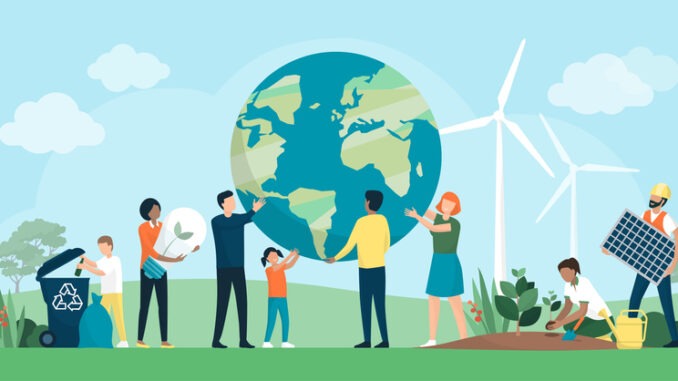[ad_1]

Kent Buse and Sofia Gruskin reflect on the recent recognition of the universal right to a healthy environment – and outline actions to help accelerate the realisation of this right
CREDIT: This is an edited version of an article that originally appeared on The BMJ
A concern with human rights would seem to be a no-brainer, but the COP26 negotiations last year were sadly deficient, both in recognising the impacts of climate on the health and rights of vulnerable populations, as well as in marshalling the monitoring and legal accountability mechanisms that a human rights framing can offer. Of particular importance, on the 8 October 2021, the UN Human Rights Council (HRC) adopted a landmark resolution confirming the right to a safe, clean, healthy and sustainable environment, and called on countries around the world to work together towards its implementation.
The need for a right ‘to an environment of a quality that permits a life of dignity and wellbeing’ was first recognised in 1972 at the UN Conference on the Environment in Stockholm. Since that time a number of countries have recognised this right in national legislation, and support for viewing the content of this right as universal and fundamental has grown. Initially championed by the Maldives, and a small number of particularly vulnerable states, support and leadership has been provided by two successive UN special rapporteurs. A civil society campaign ensued, and earlier this year the idea gained the backing of the UN Secretary-General and 15 UN agencies.
Key to the resolution is recognition of the right to participate in relevant decision-making processes, to have access to environmental information and the ability to seek and secure an effective remedy when breaches occur. It encourages states to build capacities to protect the environment as part of fulfilling their human rights obligations and commitments, and to adopt relevant policies – including with respect to biodiversity and ecosystems.
So, why does the recognition by the Human Rights Council matter? Mainly because it is a concrete step towards climate justice, but it will only be effective if we use it. Even as COP26 largely failed to draw on human rights in the final outcome document, the Council’s adoption gives advocates, and all who care about the environment, a powerful hook to work with. A ‘right’ means states have legal responsibility for their action and inaction. To date, organisations like AIDA use the power of international law in litigation and other activities, and this right can be used around the globe to hold governments and businesses to account for planetary health.
Despite the resistance of governments in the COP negotiation, and more generally, respect, protection and fulfilment of human rights are essential to a healthy and sustainable environment.
Harmful impacts
One need only think of how the harmful impacts of climate change are experienced most profoundly by populations who are already suffering from discrimination and marginalisation. These include indigenous people, minorities, migrants, rural workers, people with disabilities, women, people from LGBTQI communities, the poor – and all the more by people living two or more of these intersecting realities. Climate discrimination, in turn, has significant effects on people’s ability to realise other human rights threatened by the climate crisis—the right to health, education, employment, housing, work, water and food, to name a few. The climate emergency, toxic pollution, a loss of biodiversity and their sequelae – such as the growth of zoonotic diseases – and their pernicious impacts on the most vulnerable, provide some of the urgency to the realisation of this belatedly recognised right.
Although the resolution is non-binding, it nevertheless holds significant potential. To start, a healthy environment is critical to health and wellbeing. A rights-based approach, as set forth by the resolution, can lead to new conversations with institutions of power about the connections between their actions, the environment and health. This can, in turn, lead to accelerated action to address the environmental determinants of health, and may result in new or higher standards of environmental protections and hence more ambitious actions. Among other things, this can include protections for people, such as climate migrants.
Moreover, this recognition of a right at the global level can spur legislation at regional, national and local levels, ultimately supporting civil society to hold governments to account for their actions. Ultimately, this rights-framing can provide protections for the work of environmental defenders and campaigners, leading to a virtuous circle which simultaneously safeguards both people and planet.
Yet, even as recognition of the right to a healthy environment holds great potential, it will only matter if states give it effect; we can all play a role in making this happen. We can demand that governments take actions to protect the environment from the most local forums to the most global, including in the UN General Assembly, and support the climate and justice movements in their efforts to secure this right. We can encourage governments to bring this right into their domestic laws, and ensure that its implementation is then prioritised – including in terms of resources, training and budget allocations. We can ask civil society and academia to ensure constant monitoring and review of the content of the right, with particular attention to the impacts of climate on the most marginalised in all societies.
Together, we can insist that governments take into account their human rights obligations and commitments relating to the enjoyment of a safe, clean, healthy and sustainable environment in the implementation of, and follow-up to, COP26 and the Sustainable Development Goals. This will require not only work within countries, but across countries. Importantly, it will require governments to take bold and courageous actions to tackle interests which run counter to climate justice; in order to do so, leaders need our collective support.
Now is the time to ensure people know about, and claim, the right to a healthy environment and, thereby, help humanity to recalibrate our relationship with nature.
[ad_2]




